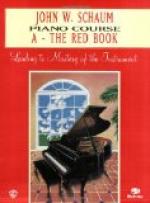Michael von Zadora, pianist and teacher, said to me recently: “Suppose you have a difficult passage to learn by heart. The ordinary method of committing to memory is to play the passage over and over, till the fingers grow accustomed to its intervals. That is not my manner of teaching. The only way to master that passage is to analyze it thoroughly, know just what the notes are, the sequences of notes, if you will, their position on the keyboard, the fingering, the positions the hands must take to play these notes, so that you know just where the fingers have to go before you put them on the keys. When you thus thoroughly understand the passage or piece, have thought about it, lived with it, so that it is in the blood, we might say, the fingers can play it. There will be no difficulty about it and no need for senseless repetitions.”
PHRASE BY PHRASE
Most of the artists agree that memorizing must be done phrase by phrase, after the composition has been thoroughly analyzed as to keys, chords, and construction. This is Katharine Goodson’s way, and also Eleanor Spencer’s and Ethel Leginska’s, three of Leschetizky’s pupils now before the public. “I really know the composition so thoroughly that I can play it in another key just as well as the one in which it is written, though I do not always memorize it each hand alone,” says Miss Goodson. “I first play the composition over a few times to become somewhat familiar with its form and shape,” says Eleanor Spencer, “then I begin to analyze and study it, committing it by phrases, or ideas, one or two measures at a time. I do not always take the hands alone, unless the passage is very intricate, for sometimes it is easier to learn both hands together.” Germaine Schnitzer avers that she keeps at a difficult passage until she really knows it perfectly, no matter how long it takes. “What is the use of going on,” she says, “until you are absolutely sure of the work in hand.”
It is plain from the opinions already cited and from many I have heard expressed that the artists waste no time over useless repetitions. They fully realize that a piece is not assimilated nor learned until it is memorized. When they have selected the composition they wish to learn, they begin at once to memorize from the start. The student does not always bring to his work this definiteness of aim; if he did, much precious time would be saved. The ability to memorize ideas expressed in notes grows with use, just as any other aptitude grows with continued effort.
Instead, then, of playing with a piece, why do you not at once begin to make it your own? Look at the phrases so intently that they become as it were, photographed on your mind. Ruskin said: “Get the habit of looking intently at words.” We might say the same of notes. Look at the phrase with the conviction that it can be remembered after a glance or two. It is only an indication of indolence and mental inertness to look continually at the printed page or passage and keep on playing it over and over, without trying to fix it indelibly in the mind.




